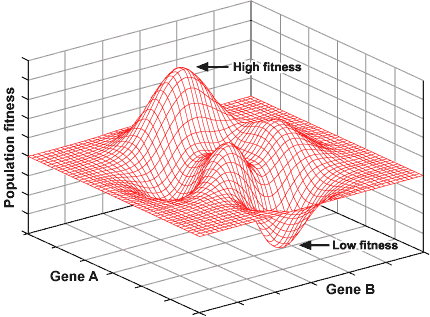Theodosius Dobzhansky, a famous Russian geneticist and evolutionary biologist, once said, "Nothing in biology makes sense except in the light of evolution."
Fig. 1. Theodosius Dobzhansky, c. 1966. Photo
from Wikipedia. No photographer specified.
So, what is evolution? How do we know it is happening? Evolution seems pretty qualitative to me. It's the gradual change of a group of organisms, and generally it is pretty hard for us to detect. It's sort of analogous to watching a tree grow or your skin tanning in the sun. You don't notice it happening, but you notice a difference later. To a human, these things are only detectable with long-term monitoring.
Evolution is like this, too. It is not sudden and it is not creative. Characteristics a species already has over time slowly change. So if you can measure traits, you can measure evolution.
Over the years, evolutionary ecologists have tried to create standards for measuring trait change. This is hard considering all the different traits possible in all of nature, but it's better than saying, "these trees look shorter than twenty years ago. They must have evolved." We needed a way to quantify trait change, so ecologists came up with units of evolution. They are generally summarized below.
~~~~~~~~~~~~~~~Units of Evolution~~~~~~~~~~~~~~~
The darwin examines the average value of a trait and compares it to the average value of that trait in the past. For example, if average tree height in a population today is 40 m, and 20 years ago it was 50 m, in darwins this is expressed as ln(40) - ln(50) divided by 20 years.
The haldane examines proportional trait change over time. It takes into account the variation in trait change, which standardizes change for easier comparisons between different populations. Basically you take the difference in the trait means, divide by a standard deviation calculation, and then divide by time, often expressed in generations.
(The information on haldanes is from a University of Michigan page on Gingerich for which there is a link above.)
~~~~~~~~~~~~~~~**********~~~~~~~~~~~~~~~
Traditionally, evolutionary change was seen as taking millennia or eons to occur and being irreversible. However, now that evolution is widely accepted as being able to occur in just a handful of generations (even one generation), there is no reason for it to be irreversible. This is the idea captured in the concept of fitness landscapes. I won't explain fitness landscapes now, but in a nutshell they teach that evolution is ongoing and in a variety of directions.
Fig. 2. An example of an adaptive landscape (also called a fitness landscape) from a TradeStation forum.
I think it would be cool if someone developed a fitness landscape with a time dimension!
I think it would be cool if someone developed a fitness landscape with a time dimension!
This idea of irreversible genetic change is likely why the term "plastic" arose to describe non-genetic changes in traits. However, this is a misleading name because it implies that (a) genetic changes are irreversible and (b) non-genetic changes are more likely to be reversible, both of which I'm not entirely convinced are necessarily true.
Finally, I think it is easy to forget among all the measurement-taking and mathematical analyses what evolution really is. It is one thing to say that nothing in biology makes sense except in the light of evolution; it is another thing to say that nothing in biology makes sense except in the light of regressional correlations between quantitative measures of natural characteristics.
Lastly, I want to add that I am still a student and I in no way claim to be an expert on any of this.
Conclusions:
It is important to understand that evolution is another way of saying change. Nothing in biology makes sense except if you acknowledge that nature is constantly interacting and adapting to change. Evolution is ecology over time.

No comments:
Post a Comment